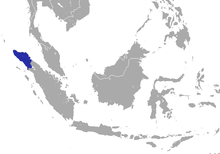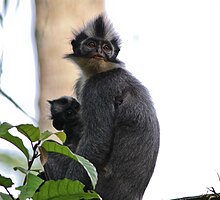Thomas's langur
| Thomas's langur[1] | |
|---|---|

| |
| Adult at the Bukit Lawang sanctuary. | |
| Scientific classification | |
| Domain: | Eukaryota |
| Kingdom: | Animalia |
| Phylum: | Chordata |
| Class: | Mammalia |
| Order: | Primates |
| Suborder: | Haplorhini |
| Infraorder: | Simiiformes |
| Family: | Cercopithecidae |
| Genus: | Presbytis |
| Species: | P. thomasi
|
| Binomial name | |
| Presbytis thomasi (Collett, 1893)
| |

| |
| Thomas's langur range | |
Thomas's langur (Presbytis thomasi), also known as the North Sumatran leaf monkey or Thomas's leaf monkey, is a species of primate in the family Cercopithecidae. It is endemic to northern Sumatra, Indonesia,[3] not living to the south and east of Lake Toba and the Alas and Wampu rivers.[4] Its natural habitat is subtropical or tropical dry forests. It is threatened by habitat loss.[2] Its native names are reungkah in Acehnese and kedih in Alas.[5] It can be found in Gunung Leuser National Park, where substantial populations exist in Ketambe and Bukit Lawang.[3]
Diet
Although primarily folivorous (leaf eating), Thomas Leaf Monkeys also eat fruit, flowers and occasionally toadstools and snails. As a member of the langur family presbytis, they have stomachs evolved to digest cellulose and microbes in the gut extract nutrients from leaves.[6] Reflected in this diet of leaves is the extent to which they do consume fruit, which is usually unripe and with high ph levels to avoid killing the microbes they need to digest leaves. Thomas Langurs also drink from holes in trees where water collects or small pools[3][6]
Conservation
Due to the ongoing deforestation of the Leuser and Ulu Massen Ecosystems in Northern Sumatra, Thomas Langurs are threatened with extinction. They are protected by Indonesian Law under Cites Appendix II and as Vulnerable by the IUCN.[3]. Although not as endangered as the charismatic megafauna they share their habitat with, such as the critically endangered Sumatran Orangutan and Sumatran Elephant, the population of Thomas Langurs have declined by thirty percent in the last few decades. As their habitat continues to erode due to human activity, they come into conflict with people, moving into croplands where they become victims of the illegal pet trade and are seen as pests by farmers, who cull them in large numbers with firearms. Like many other animals in SE Asia, Thomas Langurs are also dismembered and their parts sold for medicine.
Although protected by Indonesian Law, Thomas Langurs are becoming habituated to tourists who visit Gunung Leuser National Park. Though discouraged and prohibited, humans feed Thomas Langurs and other primates in the park causing negative consequences for wildlife and people.[6]

References
- ^ Groves, C. P. (2005). Wilson, D. E.; Reeder, D. M. (eds.). Mammal Species of the World: A Taxonomic and Geographic Reference (3rd ed.). Baltimore: Johns Hopkins University Press. p. 172. ISBN 0-801-88221-4. OCLC 62265494.
- ^ a b Setiawan, A.; Traeholt, C. (2020). "Presbytis thomasi". IUCN Red List of Threatened Species. 2020: e.T18132A17954139. doi:10.2305/IUCN.UK.2020-2.RLTS.T18132A17954139.en. Retrieved 16 November 2021.
- ^ a b c d Suprianta, Jatna (January 25, 2022). Field Guide to the Primates of Indonesia. Switzerland: Springer. pp. 126–127. ISBN 978-3-030-83205-6.
- ^ NA, NA (2011). "Leaf Monkeys". bukitlawang.com. Retrieved April 26, 2024.
{{cite web}}: CS1 maint: url-status (link) - ^ Biodiversitas Rawa Tripa
- ^ a b c Downey, Kathleen (May 2018). "Thomas Leaf Monkey Presbytis thomasi". New England Primate Conservancy. Retrieved April 24, 2024.
- CS1 maint: url-status
- Articles with short description
- Short description is different from Wikidata
- IUCN Red List vulnerable species
- Articles with 'species' microformats
- Presbytis
- Endemic fauna of Sumatra
- Primates of Indonesia
- Vulnerable fauna of Asia
- Mammals described in 1893
- Taxonomy articles created by Polbot
- Taxa named by Robert Collett
- All stub articles
- Old World monkey stubs
